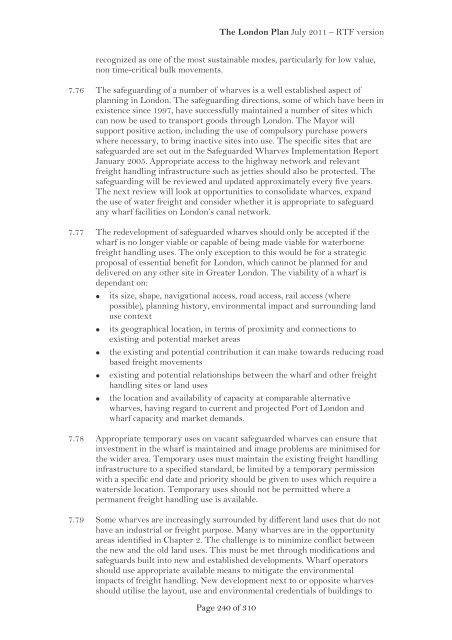London Plan 2011 PDF 1 MB - Lambeth Council
London Plan 2011 PDF 1 MB - Lambeth Council
London Plan 2011 PDF 1 MB - Lambeth Council
Create successful ePaper yourself
Turn your PDF publications into a flip-book with our unique Google optimized e-Paper software.
The <strong>London</strong> <strong>Plan</strong> July <strong>2011</strong> – RTF version<br />
recognized as one of the most sustainable modes, particularly for low value,<br />
non time-critical bulk movements.<br />
7.76 The safeguarding of a number of wharves is a well established aspect of<br />
planning in <strong>London</strong>. The safeguarding directions, some of which have been in<br />
existence since 1997, have successfully maintained a number of sites which<br />
can now be used to transport goods through <strong>London</strong>. The Mayor will<br />
support positive action, including the use of compulsory purchase powers<br />
where necessary, to bring inactive sites into use. The specific sites that are<br />
safeguarded are set out in the Safeguarded Wharves Implementation Report<br />
January 2005. Appropriate access to the highway network and relevant<br />
freight handling infrastructure such as jetties should also be protected. The<br />
safeguarding will be reviewed and updated approximately every five years.<br />
The next review will look at opportunities to consolidate wharves, expand<br />
the use of water freight and consider whether it is appropriate to safeguard<br />
any wharf facilities on <strong>London</strong>’s canal network.<br />
7.77 The redevelopment of safeguarded wharves should only be accepted if the<br />
wharf is no longer viable or capable of being made viable for waterborne<br />
freight handling uses. The only exception to this would be for a strategic<br />
proposal of essential benefit for <strong>London</strong>, which cannot be planned for and<br />
delivered on any other site in Greater <strong>London</strong>. The viability of a wharf is<br />
dependant on:<br />
• its size, shape, navigational access, road access, rail access (where<br />
possible), planning history, environmental impact and surrounding land<br />
use context<br />
• its geographical location, in terms of proximity and connections to<br />
existing and potential market areas<br />
• the existing and potential contribution it can make towards reducing road<br />
based freight movements<br />
• existing and potential relationships between the wharf and other freight<br />
handling sites or land uses<br />
• the location and availability of capacity at comparable alternative<br />
wharves, having regard to current and projected Port of <strong>London</strong> and<br />
wharf capacity and market demands.<br />
7.78 Appropriate temporary uses on vacant safeguarded wharves can ensure that<br />
investment in the wharf is maintained and image problems are minimised for<br />
the wider area. Temporary uses must maintain the existing freight handling<br />
infrastructure to a specified standard, be limited by a temporary permission<br />
with a specific end date and priority should be given to uses which require a<br />
waterside location. Temporary uses should not be permitted where a<br />
permanent freight handling use is available.<br />
7.79 Some wharves are increasingly surrounded by different land uses that do not<br />
have an industrial or freight purpose. Many wharves are in the opportunity<br />
areas identified in Chapter 2. The challenge is to minimize conflict between<br />
the new and the old land uses. This must be met through modifications and<br />
safeguards built into new and established developments. Wharf operators<br />
should use appropriate available means to mitigate the environmental<br />
impacts of freight handling. New development next to or opposite wharves<br />
should utilise the layout, use and environmental credentials of buildings to<br />
Page 240 of 310
















